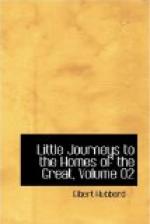These friendless old souls used to meet and mix at the Lambs’ with those whose names are now deathless. You can not write the history of English Letters and leave the Lambs out. They were the loved and loving friends of Southey, Wordsworth, Coleridge, De Quincey, Jeffrey and Godwin. They won the recognition of all who prize the far-reaching intellect—the subtle imagination. The pathos and tenderness of their lives entwine us with tendrils that hold our hearts in thrall.
They adopted a little girl, a beautiful little girl by the name of Emma Isola. And never was there child that was a greater joy to parents than was Emma Isola to Charles and Mary. The wonder is they did not spoil her with admiration, and by laughing at all her foolish little pranks. Mary set herself the task of educating this little girl, and formed a class the better to do it—a class of three: Emma Isola, William Hazlitt’s son and Mary Victoria Novello. I met Mary Victoria once; she’s over eighty years of age now. Her form is a little bent, but her eye is bright and her smile is the smile of youth. Folks call her Mary Cowden-Clarke.
And I want you to remember, dearie, that it was Mary Lamb who introduced the other Mary to Shakespeare, by reading to her the manuscript of the “Tales.” And further, that it was the success of the “Tales” that fired Mary Cowden-Clarke with an ambition also to do a great Shakespearian work. There may be a question about the propriety of calling the “Tales” a great work—their simplicity seems to forbid it—but the term is all right when applied to that splendid life-achievement, the “Concordance,” of which Mary Lamb was the grandmother.
Emma Isola married Edward Moxon, and the Moxon home was the home of Mary Lamb whenever she wished to make it so, to the day of her death. The Moxons did good by stealth, and were glad they never awoke and found it fame.
“What shall I do when Mary leaves me, never to return?” once said Charles to Manning. But Mary lived for full twenty years after Charles had gone, and lived only in loving memory of him who had devoted his life to her. She seemed to exist just to talk of him and to garland the grave in the little old churchyard at Edmonton, where he sleeps. Wordsworth says, “A grave is a tranquillizing object: resignation in time springs up from it as naturally as wild flowers bespread the turf.” Her work was to look after the “pensioners” and carry out the wishes of “my brother Charles.”
But the pensioners were laid away to rest, one after the other, and the gentle Mary, grown old and feeble, became a pensioner, too, but thanks to that divine humanity that is found in English hearts, she never knew it. To the last, she looked after “the worthy poor,” and carried flowers once a year to the grave of the gallant Captain Reynolds at Highgate, and never tired of sounding the praises of Charles and excusing the foibles of Coleridge. She lived only in the past, and its loving memories were more than a ballast ’gainst the ills of the present.




